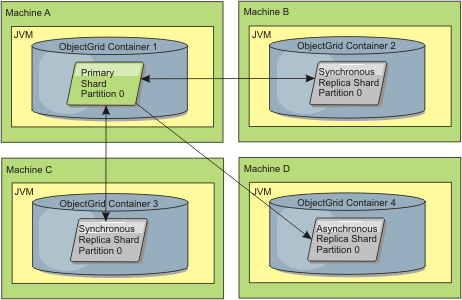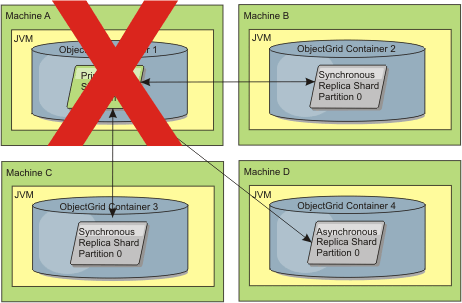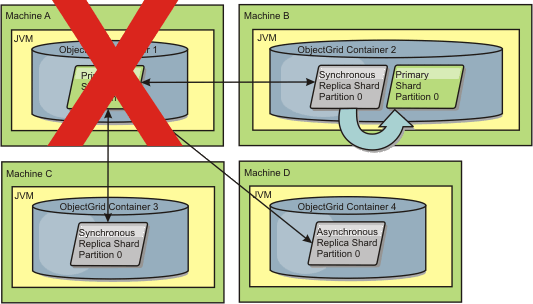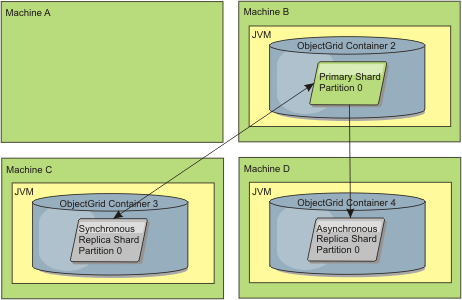WebSphere eXtreme Scale Product Overview > Availability > Replication for availability > Shard allocation: primary and replica
|
| |
Life cycle, recovery, and failure events
Shards go through different states and events to support replication. The life cycle of a shard includes coming online, run time, shut down, fail over and error handling. Shards can be promoted from a replica shard to a primary shard to handle server state changes.
Life cycle events
When primary and replica shards are placed and started, they go through a series of events to bring themselves online and into listening mode.
Primary
shard
The catalog service places a primary shard for a partition. The catalog service also does the work of balancing primary shard locations and initiating failover for primary shards.
When a shard becomes a primary shard, it receives a list of replicas from the catalog service. The new primary shard creates a replica group and registers all the replicas.
When the primary is ready, an open for business message displays in the SystemOut.log file for the container on which it is running. The open message, or the CWOBJ1511I message, lists the map name, map set name, and partition number of the primary shard that started.
CWOBJ1511I: mapName:mapSetName:partitionNumber (primary) is open for business.
See Shard allocation: primary and replica for more information on how the catalog service places shards.
Replica shard
Replica shards are mainly controlled by the primary shard unless the replica shard detects a problem. During a normal life cycle, the primary shard places, registers, and de-registers a replica shard.
When the primary shard initializes a replica shard, a message displays the log that describes where the replica runs to indicate that the replica shard is available. The open message, or the CWOBJ1511I message, lists the map name, map set name, and partition number of the replica shard. This message follows:
CWOBJ1511I: mapName:mapSetName:partitionNumber (synchronous replica) is open for business.
or
CWOBJ1511I: mapName:mapSetName:partitionNumber (asynchronous replica) is open for business.
When the replica shard first starts, it is not yet in peer mode. When a replica shard is in peer mode, it receives data from the primary as data comes into the primary. Before entering peer mode, the replica shard needs a copy of all of the existing data on the primary shard.
To get a copy of the data on the primary shard, both synchronous and asynchronous replica shards perform the same startup sequence. During the registration of the replica shard, the primary shard creates a checkpoint of the current data. The data on the primary shard is in a copy-on-write state. The current data that is going to the replica shard is never modified, but a copy-on-write is performed whenever a new transaction updates records on the primary. The primary shard is able to continue processing without changing the data that is going to the replica shard. The primary shard keeps a list of the changes that were made since the checkpoint.
The checkpoint data is pushed to the replica. After the checkpoint arrives at the replica, the memory for the checkpoint is released. The changes since the checkpoint was created are merged. The list of changes are also pushed to the replica shard. As the changes are pushed across, the memory for the change is released.
After the replica completes the checkpoint phase, it switches into peer mode and begins to receive data as the primary receives the data. At this point, the replica shard starts to behave as either a synchronous or an asynchronous replica shard.
When a replica shard reaches peer mode, it prints a message to the SystemOut.log file for the replica.
CWOBJ1526I: Replica objectGridName:mapsetName:partitionNumber:mapName entering peer mode after X seconds.
The time refers to the amount of time that it took the replica shard to get all of its initial data from the primary shard, including the checkpoint data and any additional changes that are made during the checkpoint copy. The time might display as zero or very low if the primary shard does not have any existing data to replicate.
Synchronous replica shard
If the new replica is a synchronous replica shard, the primary shard now starts a request or response whenever a transaction commits on the primary. The primary shard waits until the replica shard responds that it got the data. The synchronous replica shard data remains at the same level as the primary shard data.
Asynchronous replica shard
If the new replica is an asynchronous replica shard, the primary shard sends the data to the replica, but it does not wait for a response. The asynchronous replica orders and applies the data sent from the primary. The asynchronous replica data shard is not guaranteed to remain at the same level as the primary shard data.
Peer mode for all replica shards
When you are in peer mode, after all replica shards receive a transaction change, then the memory for the transaction is released on the primary shard. The replica shards only receive data from the primary shard during transactions that change data such as inserts, updates and removes. They replica shards are not contacted for reading data on the primary shard.
Recovery events
Replication is designed to recover from failure and error events. If a primary shard fails, another replica takes over. If errors are on the replica shards, the replica shard attempts to recover. The catalog service controls the placement and transactions of new primary shards or new replica shards.
Replica
shard becomes a primary shard
A replica shard becomes a primary shard for two reasons. Either the primary shard stopped or failed, or a balance decision was made to move the previous primary shard to a new location.
The catalog service selects a new primary shard from the existing synchronous replica shards. The new primary shard registers all of the existing replicas and accepts transactions as the new primary shard. If the existing replica shards have the correct level of data, the current data is preserved as the replica shards register with the new primary shard. If an asynchronous replica shard was behind, it receives a fresh copy of the data and register.
Figure 1. Example placement of an ObjectGrid map set for the partition0 partition. The deployment policy has a minSyncReplicas value of 1, a maxSyncReplicas value of 2, and a maxAsyncReplicas value of 1.
 shards. Machine D has an asynchronous replica shard." />
shards. Machine D has an asynchronous replica shard." />
Figure 2. The container for the primary shard fails

Figure 3. The synchronous replica shard on ObjectGrid container 2 becomes the primary shard

Figure 4. Machine B contains the primary shard. Depending on how automatic repair mode is set and the availability of the containers, a new synchronous replica shard might or might not be placed on a machine.

A replica shard is controlled by the primary shard. However, if a replica shard detects a problem, it can trigger a reregister event to correct the state of the data. The replica clears the current data and gets a fresh copy from the primary.
When a replica shard initiates a reregister event, the replica prints a log message.
CWOBJ1524I: Replica listener objectGridName:mapSetName:partition must re-register with the primary. Reason: Exception listed
If a transaction causes an error on a replica shard during processing, then the replica shard is in an unknown state. The transaction successfully processed on the primary shard, but something went wrong on the replica.
To correct this situation, the replica initiates a reregister event. With a new copy of data from the primary, the replica shard can continue. If the same problem reoccurs, the replica shard does not continuously reregister. See Failure events for more details.
Failure events
A replica can stop replicating data if it encounters error situations for which the replica cannot recover.
Too many register attempts
If a replica triggers a reregister multiple times without successfully committing data, the replica stops. Stopping prevents a replica from entering an endless reregister loop. By default, a replica shard tries to reregister three times in a row before stopping.
If a replica shard reregisters too many times, it prints the following message to the log.
CWOBJ1537E: objectGridName:mapSetName:partition exceeded the maximum number of times to reregister (timesAllowed) without successful transactions..
If the replica is unable to recover by reregistering, a pervasive problem might exist with the transactions that are relative to the replica shard. A possible problem could be missing resources on the classpath if an error occurs while inflating the keys or values from the transaction.
Failure
while entering peer mode
If a replica attempts to enter peer mode and experiences an error processing the bulk existing data from the primary (the checkpoint data), the replica shuts down. Shutting down prevents a replica from starting with incorrect initial data. Because it receives the same data from the primary if it reregisters, the replica does not retry.
If a replica shard fails to enter peer mode, it prints the following message to the log:
CWOBJ1527W Replica objectGridName:mapSetName:partition:mapName failed to enter peer mode after numSeconds seconds.
An additional message displays in the log that explains why the replica failed to enter peer mode.
Recovery after re-register or
peer mode failure
If a replica fails to re-register or enter peer mode, the replica is in an inactive state until a new placement event occurs. A new placement event might be a new server starting or stopping. You can also start a placement event by using the triggerPlacement method on the PlacementServiceMBean Mbean.